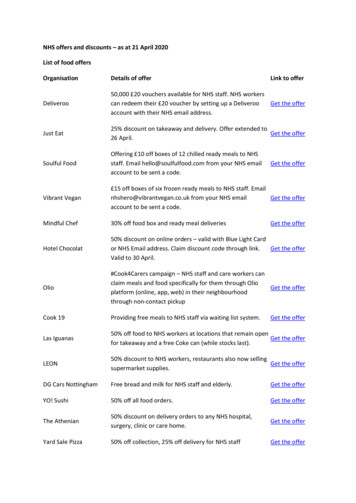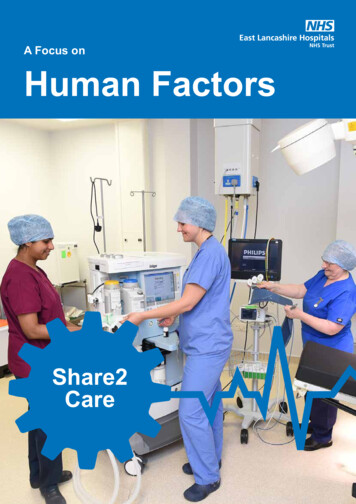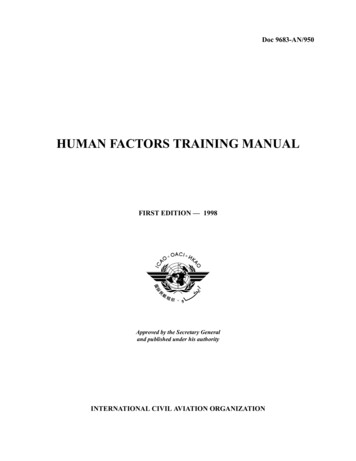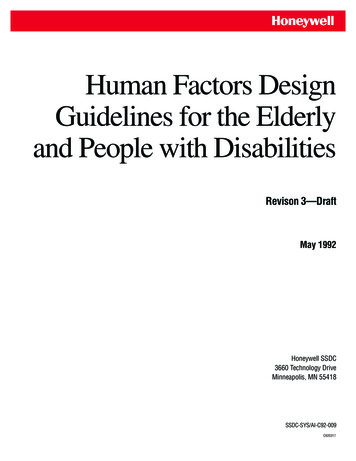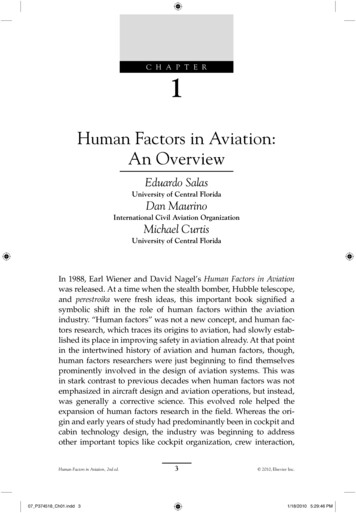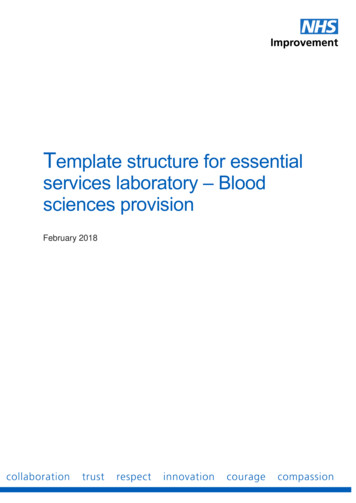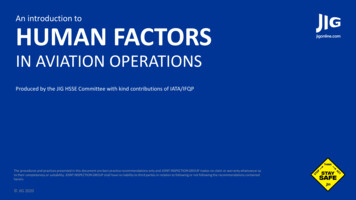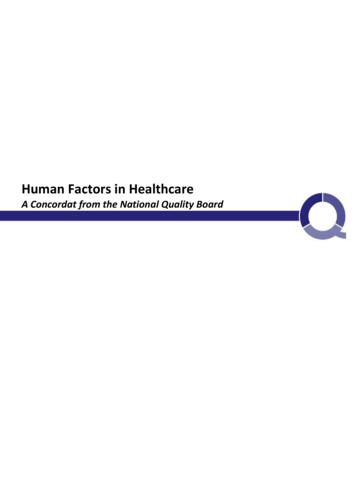
Transcription
Human Factors in HealthcareA Concordat from the National Quality BoardNovember 2013
Patient StoriesA patient was given an unnecessary knee operation1Two patients with the same name were set up with one set of medical notes and hence the samehospital number. They had different medical conditions that required hospital appointments indifferent departments, however, they both just happened to have knee pain at the same time. Thewrong patient arrived and had the procedure intended for the other.How did this happen? Four different hospital numbers were recorded in the patient’s medical notes, along withmore than one GP and several different addresses. The hospital used patient identifier labels so one mistaken patient detail could be replicatedmany times. An independent translator wasn’t always available when either patient turned up for thetreatment of their different conditions. Neither the consent form nor the pre-operation assessment form were properly completed.A child with a known penicillin allergy was prescribed and administered anintravenous dose of an antibiotic of the penicillin class2A child was due to have a pacemaker fitted. On pre-admission an allergy to penicillin was recorded.This was noted on both the nursing admission assessment form and the anaesthetic record chart.Prior to operation, the allergy was discussed with the specialist paediatric cardiology registrar, theconsultant paediatric anaesthetist, anaesthetic specialist registrar and the cardiology consultant.However, following the procedure the patient’s plan included intravenous and oral penicillin.How did this happen? Intravenous penicillin is the usual antibiotic used following a pacemaker being fitted. Therewas no up-to-date protocol on what other antibiotics should be used if a paediatric cardiacpatient has a penicillin allergy, which initially caused confusion; There was no clear record of the allergy in the medical notes when the ConsultantCardiologist advised treatment; No system was in place to prevent penicillin prescription when a known allergy was recorded. A number of appropriate checks were not followed prior to administration of the antibiotics. During independent checks, neither nurse checked allergy status, and both were underpressure to complete tasks. The patient’s allergy band was on the same side as their identityband, both of which were covered with a bandage for an intravenous drip.2
Human Factors in HealthcareWhat are Human Factors in healthcare?“Enhancing clinical performance through an understanding of the effects of teamwork, tasks,equipment, workspace, culture and organisation on human behaviour and abilities and application ofthat knowledge in clinical settings”.3The primary purpose of the NHS is to deliver high quality care to all, free at the point of need. Highquality care encompasses care that is safe, clinically effective, and results in as positive anexperience for patients as possible.However, delivering healthcare can place individuals, teams and organisations under pressure. Staffhave to make difficult decisions in dynamic, often unpredictable circumstances. In such intensesituations, decision making can be compromised, impacting on the quality of care, clinical outcomes,and potentially causing harm to the patient; poor performance also increases costs. A series of casestudies demonstrating what can happen when things go wrong are included at Annex A.The NHS needs to create the conditions where the safety of those accessing NHS-funded healthservices is the primary concern.The value of Human Factors for the NHSHuman Factors, often referred to as ergonomics, is an established scientific discipline used in manyother safety critical industries. Human Factors approaches underpin current patient safety andquality improvement science, offering an integrated, evidenced and coherent approach to patientsafety, quality improvement and clinical excellence.The principles and practices of Human Factors focus on optimising human performance throughbetter understanding the behaviour of individuals, their interactions with each other and with theirenvironment. By acknowledging human limitations, Human Factors offers ways to minimise andmitigate human frailties, so reducing medical error and its consequences. The system-wide adoptionof these concepts offers a unique opportunity to support cultural change and empower the NHS toput patient safety and clinical excellence at its heart.Human Factors principles can be applied in the identification, assessment and management ofpatient safety risks, and in the analysis of incidents to identify learning and corrective actions.More broadly, Human Factors understanding and techniques can be used to inform qualityimprovement in teams and services, support change management, and help to emphasise theimportance of the design of equipment, processes and procedures.The NHS has already started to harness Human Factors approaches through the successful adoptionof patient safety and quality improvement science, and in the ergonomic design of medical devicesand workplaces.There is, however, further learning that can be adopted and adapted from best practice to minimiserisk to patients and so optimise human performance in healthcare. The NHS must learn where it canfrom other high reliability industries where safety of employees and customers is paramount such asnuclear, petro-chemical, military operations, rail, maritime, civil aviation and emergency services.3
This means acknowledging that Human Factors is not a separate agenda or programme, but a way ofthinking that should be incorporated as part of the design of processes, jobs and training.A series of case studies at Annex B demonstrate how Human Factors principles and practices arebeing applied to the benefit of patients in the NHS.4
The ConcordatWe, the undersigned, believe that a wider understanding of Human Factors principles and practiceswill contribute significantly to improving the quality (effectiveness, experience and safety) of care forpatients.We commit to supporting the National Health Service to optimise its leadership, systems andprocesses, design, education and training, regulation and quality assurance, to build a highperforming, resilient and efficient healthcare system which protects patients by minimising humanerrors in healthcare delivery and is constantly aspiring for excellence through quality improvement.So, supporting the NHS to do the right thing first time, every time.Our principlesWe acknowledge that much of the activity to embed Human Factors in healthcare sits with frontlineproviders; although commissioners, regulators and other organisations have key enabling roles.In supporting the NHS to understand and adopt Human Factors principles and practices, we committo: raising awareness and promoting Human Factors principles and practices in healthcare; understanding, identifying and addressing current capability, barriers to adoption, futurerequirements and best practice in Human Factors in healthcare; creating the appropriate conditions, through commissioning, quality assurance andregulation, that support the NHS in embedding Human Factors at a local level.Our CommitmentThe National Quality Board – which brings together different national organisations withresponsibility for quality in the NHS, alongside patient representatives and experts - will provideleadership and oversight for embedding Human Factors principles and practices, bringing togetherall levels of the system to support: strong leadership and understanding for Human Factors in the NHS; inclusion of Human Factors principles and practices in core education and training curriculafor health professionals and managers and to support on-going professional development; the development of a just, open and positive organisational culture that optimises humanperformance, supports strong, respectful and accountable working relationships;acknowledges the potential for human error at all levels; and, ensures a systematic approachto best practice through proactive identification of risk, effective debriefing, learning fromfeedback and complaints, and dissemination of learning; alignment of the system to embed an understanding of Human Factors principles andpractices, including a commitment to developing genuine ‘Learning Organisations’ whichfocus on delivering high quality care; standardisation of clinical care, where evidenced through guidelines, care pathways andprotocols; and,5
supporting commissioning and procurement that embeds Human Factors principles andpractices.Action we are taking NHS England is harnessing Professor Don Berwick's call4 for the NHS to nurture and embracea culture of learning and continual improvement by supporting a nationwide programme ofsafety improvement collaboratives. These collaborative groups will be supported nationallyto harness improvement science and other techniques to deliver locally owned and ledprogrammes that deliver safer care. Existing examples already successfully utilise HumanFactors approaches and NHS England will ensure the use of Human Factors science isapplied, where appropriate, through the safety collaborative programme. Health Education England (HEE) is exploring how Human Factors practices and principles canbe included in the curricula and training frameworks for health professionals. The Care Quality Commission (CQC) is radically changing its assessment of quality in NHSorganisations, and in doing so is embedding Human Factors principles within its assessmentof how safe, effective, caring, responsive and well-led organisations are; with a particularfocus on developing just and open cultures, that encourage learning from mistakes andconsider how alert staff are to emerging risk. To improve recommendations on patient safety, the National Institute for Health and CareExcellence (NICE) is considering how evidence on Human Factors can be taken into accountin the development of clinical guidelines. Human Factors are of undoubted importance in public health work, for instance around themanagement of outbreaks of communicable diseases and in the management of seriousincidents. Public Health England (PHE) is working with partners to identify how HumanFactors principles can support the delivery of high quality, safe public and population healthservices that contribute to improving and protecting the public’s health. The NHS Trust Development Authority (NHS TDA) is considering how it can best reflectHuman Factors principles as part of its oversight, support and development of NHS trusts. The General Medical Council has reflected the importance of recognising Human Factors inthe development of generic professional capabilities for post graduate medical curricula.The context for this is the GMC’s core guidance for all doctors, Good medical practice, whichsets out what is expected of doctors, including communication and partnership working withpatients. The Nursing and Midwifery Council (NMC) is interested in the impact of Human Factors onthe practice of nurses and midwives. Human Factors will inform the review of their code ofconduct and practice for nurses and midwives in 2014 and education standards in duecourse. NHS Employers will use its extensive communication and engagement channels with NHSemployer organisations to ensure that the evidence base for Human Factors and its practicalapplication is made readily available. Through its work with employers on organisational6
development, cultural change and supporting values driven behaviour, it will ensure that thisevidence base is incorporated into our programmes and resources. The Parliamentary and Health Service Ombudsman (PHSO) is developing expertise inHuman Factors science and root cause analysis to help providers learn from complaintsthrough better understanding of why mistakes happen. The NHS Leadership Academy is working to promote, educate and share the Human Factorsprinciples throughout its professional leadership programmes and health systemdevelopment work. In particular, it is ensuring Human Factors approaches are embedded inall of its programmes, are integral to its online materials and included in conversations withpartners, participants and patients. The NHS Litigation Authority (NHS LA) is developing a Safety and Learning Service for theNHS to help learning from claims. In particular, the service is providing, through a Safety andLearning Library, resources on all aspects of safety including that of Human Factors so thatorganisations can truly get to the heart of why claims occur and what can be done toprevent them in the future.Our approach moving forwardWe initiated the work that has led to this Concordat following the Mid Staffordshire NHS FoundationTrust Inquiry 20105. The report of the Mid Staffordshire NHS Foundation Trust Public Inquiry 20136further emphasised the critical importance of NHS organisations working in partnership to avoid,isolate and/or mitigate risk to high quality patient care and ensure such widespread systemic failuredoes not happen again. The intentions of and work to deliver our Concordat seek to respond to thisand to the conclusions of the National Patient Safety Advisory Group led by Professor Don Berwick7.However, this Concordat is only the starting point. For our ambitions to become a reality, HumanFactors principles and practices will need to inform all aspects of the healthcare system.This will require multiple actions at multiple levels across the system: from ensuring the workforce isaware of the application of Human Factors in everyday clinical practice, to embedding anunderstanding of human limitations and how to mitigate against their impact in the developmentand design of healthcare systems and processes. It will require every NHS organisation to commit toembedding an understanding of Human Factors in their business as usual activities and also whenthings go wrong and need investigation.If we are serious about this commitment, we need to work with NHS organisations, clinicians andNHS staff to understand their current capabilities, establish their requirements and develop a workprogramme of tailored support that enables NHS organisations to maximise the potential thatHuman Factors principles and practices can offer in relation to patient safety, efficiency andeffectiveness.Health Education England, through its education commissioning and strategic leadership will supportthe development of curricula, training frameworks and continuing professional developmentframeworks that ensure that the current and future workforce has the right skills, values andbehaviours in relation to Human Factors principles and practices.7
NHS England, on behalf of the commissioning system and through the patient safety collaborativeprogrammes will work to support the NHS in taking forward this agenda as part of the wider patientsafety and quality improvement agenda.Together, and with other signatories to this Concordat, they will take forward the following steps: Step 1: Communicate with commissioners and providers to increase their awareness andunderstanding of the concept of Human Factors, highlighting how the approach can be usedto drive improvement in quality and safety Step 2: Scope current capacity and capability in Human Factors and identify what supportand development the NHS requires to fully harness the benefits of Human Factorsapproaches throughout the system. Step 3: Develop programmes of work, based on Step 2, to be taken forward byorganisations nationally, regionally and locally to enable the NHS to embed Human Factorsprinciples and practices in its culture, systems and processes.Signed by:Care Quality CommissionDepartment of HealthHealth Education EnglandThe Parliamentary & Health Service Ombudsman for EnglandNHS EmployersNHS EnglandNHS Trust Development AuthorityMonitorNational Institute for Health and Care ExcellenceGeneral Medical CouncilHealthWatch EnglandNursing and Midwifery CouncilPublic Health EnglandSocial Care Institute for ExcellenceNHS Leadership AcademyNHS Litigation Authority8
Further information:Websites: Clinical Human Factors Group (CHFG): http://chfg.org/ Designing Out Medical Error (DOME): http://www.domeproject.org.uk/ The Health Foundation: http://www.health.org.uk/ Institute for Ergonomics and Human Factors: http://iehf.org/ Patient Safety First: http://www.patientsafetyfirst.nhs.uk/Publications: Department of Health Clinical Human Factors Reference Group Interim s/2013/11/DH-rep.pdf Never? (Appendix 2, Department of Health Reference Group Interim ds/2013/11/DH-2.pdf Implementing Human Factors in Healthcare: How to guide (volume ferCare/Human-Factors-How-to-Guidev1.2.pdf Getting to grips with Human Factors – a learning resource for ds-from-the-chfg9
ANNEXCase studiesA. What happens when things go wrongB. How Human Factors can help10
ANNEX AWhat happens when things go wrongCase studies 1-4 are taken from ‘Never?’, appendix to the Department of Health’s Clinical HumanFactors Reference Group’s Interim Report8, which summarises the key points and lessons from aseries of very different ‘never events’. Case study 5 was provided by SaIL9 at King’s Health Partners.Awareness and application of Human Factors principles and practices could potentially mitigate theoccurrence of such incidents. These examples focus on cases within a surgical setting on the whole.However, Human Factors is relevant in all aspects of healthcare, and in all sectors. The case studiesin Annex B demonstrate this.Case 1The wrong knee was investigated via arthroscopy10Issue:A patient was scheduled for a right knee arthroscopy, seen by the consultantand the consent form filled in correctly, the right leg was marked but theprocedure was carried out on the left knee until the theatre assistantnoticed and spoke up. The procedure was stopped and the right kneeinvestigated as required.What happened?---The person operating was not the same as the person taking consentand marking the site.The site marking was not prominent or undertaken in accordance withpolicy.The WHO Surgical Safety Checklist wasn’t used in this theatre and therewas no time out or verbal check of the site for surgery or position of thetable before the procedure started.The scrub nurse rotated the table for the left knee which causedconfusion and set everyone up to think it was the left knee to beoperated on.The nurse then left theatre and didn’t return until the procedure wasunderway.Additional theatre staff joined the team during the procedure butweren’t briefed.Case 2The wrong lymph node was removed and the patient had toundergo a further procedure11Issue:A patient with skin cancer noticed a swelling in their right groin. The referralletter described this to the surgeons and went on to say that an ultrasoundscan had shown an enlarged external iliac chain lymph node which had beenconfirmed as metastatic melanoma by another test. The surgical consultantcircled the words ‘right groin’ on the letter and this term was usedthereafter. The wrong site was operated on but on the correct side.What happened?-The term groin was interpreted differently by the oncologists and thesurgeons.11
--The patient didn’t have a detailed clinical assessment in the surgicalclinic, the original referral letter and report of the ultrasound were notchecked.The ultrasound scan correctly identified the lymph node group but thecytology form incorrectly described it as being from the right groin.The letter from the surgical team was sent to the patient’s GP and notcopied to the referring oncology team.The skin multi-disciplinary team never discussed imaging so the scanwas not reviewed at the meeting.The scan results were not displayed at the time of the operation and itwas recorded on the WHO Surgical Safety Checklist that imaging was notapplicable.Case 3A patient had decompressive lumbar disc surgery on the wrongside12Issue:A patient had right sided symptoms of sciatica consistent with recurrent discdisease. The patient was admitted and consented for a right far lateral Level3/4 microdiscectomy and foraminotomy (a medical procedure used toreduce pressure on compressed nerves) by the Neurosurgical SpecialistRegistrar who marked the side for the surgery with a non-permanent boardmarker and not a surgical marker pen. The consultant was late to theatrehaving been at several management meetings from early morning. Theconsultant missed the final checking and started the operation without theSpecialist Registrar present. In preparing the skin the marks washed off andthe surgeon put in a new line and proceeded to operate on the wrong side.When the error was noted the patient was still in the recovery area so, withtheir agreement, they were taken back to theatre and the correct procedurewas performed.What happened?----The patient was seen by the anaesthetist and the Specialist Registrar andthey completed a local checklist and the first part of the WHO Checklist.The patient was transferred to a different theatre from the one normallyused which had a different layout and different positioning of theimaging screens.The correct level of the Level 3/4 disc was confirmed using a needle andimage intensifier but the imaging machine was in demand and had to bemoved to another theatre once the level had been identified.The consultant neurosurgeon arrived in theatre as the needle was beingplaced and both surgeons confirmed that it was placed on the left.The Checklist was commenced while both surgeons were scrubbing forthe procedure. The Specialist Registrar who had previously consentedand marked the patient went and completed this while the Consultantcontinued to scrub, he couldn’t hear what was being said.As the Specialist Registrar left the timeout to finish scrubbing theConsultant neurosurgeon went into theatre to start the procedure.The consultant effectively removed all signs of the markings with theskin prep fluid. A new midline mark was applied with an indelible markerrelative to the needle used to check the level-the needle did not indicatethe side for the procedure.12
-The Specialist Registrar joined the surgery as the consultant made amidline incision and proceeded to perform the procedure on the wrongside, assisted by the Specialist Registrar.Case 4An abdominal spacer for use in radiotherapy was inserted into acancer patient on the wrong side13Issue:A young man was diagnosed with metastatic cancer arising in the left ileum(a section of the small intestine) which had spread to his lungs and bones.After chemotherapy treatment, radiotherapy was planned to the left ileum.A temporary abdominal spacer had to be inserted to position the patient’sbowel away from the radiotherapy field to reduce radiation toxicity and tominimise any side effects. The spacer was inserted on the wrong side bymistake.What happened?-----When booking the patient into theatre, the Senior House Officer usedthe wrong code that suggested excision of the ileum. The medical noteswere not available for the surgical planning meeting.The patient refused to sign the consent form as he knew he wasn’thaving his ileum removed. The Specialist Registrar was called out oftheatre to review the patient and agree with them the correctprocedure. This was a busy day in theatre and the Specialist Registrarwas rushed.The patient signed the consent form for the correct procedure but onthe right side by mistake.The Specialist Registrar returned to theatre without marking the site.The side was marked after the patient was anaesthetised so couldn’tcorrect this. The trust did not have a policy for marking surgical sites.Confusion was caused by different uses of the abbreviation ‘RT’ which isused by the oncology team to refer to radiotherapy and by the surgeonsto refer to the right side. Ileum RT meant very different things to thedifferent medical teams.Two MDT cancer meetings referred to different sides in the notes andtwo important letters which would have determined the correct sidewere yet to be filed in the patient’s notes since they had deliberatelybeen kept out for the surgeon to see.Case 5A patient underwent surgery on the wrong wrist14Issue:A Foundation Year 2 doctor noted that she thought the consultant surgeonwas preparing the wrong hand for surgery, however, all staff wereprogressing as if this was the correct wrist. The Foundation Year 2 doctormade an attempt to raise the concern with the registrar, but this was notregistered and the Foundation Year 2 doctor was asked quite bluntly toremain quiet. The surgical incision was made and the operation started.After 10 minutes it was noted that the injury for which the child wasundergoing the operation was not present. The operation was thenundertaken on the correct side. The child suffered some pain, discomfortand scarring on the wrongly operated side, but made a good recovery.13
What happened?--The Foundation Year 2 doctor was very fearful of raising a concern dueto the hierachical nature of the organisation and as she had beenreprimanded before for a failure to get a patient investigated promptly.The Foundation Year 2 doctor was unsure how to raise concerns andchallenge authority, and felt a significant amount of guilt about herinability to raise this concern.14
ANNEX BHow Human Factors can helpThe case studies below have been provided by the Health Foundation15, the Helen Hamlyn Centrefor Design16, NICE17 and Patient Safety First18. The studies demonstrate the varied and widespreadapplication of Human Factors principles and approaches in healthcare and the potential for furtherapplication in the NHS.Case 6The Health Foundation’s Safer Clinical Systems improvementprogramme: Patient information flows - NHS Lothian19Project aim:To create safe and reliable systems for managing the flow of informationabout patients.Why this project?Problems had been identified with duplicate registrations and many patientshaving multiple sets of case notes on file. This contributed to a lack ofclinical information at clinics, negatively impacting on patient safety.Approach:Using a systems approach, various techniques including Human Factorsanalysis were used to diagnose the problems. The team developed a coredata set and reduced duplicate entries to an acceptable level, whilst alsointroducing a monitoring system to minimise further duplication.Outcome:Registration errors fell significantly from the start of the programme, withduplicate registrations subsequently at their lowest level. Correctregistrations rose from a baseline of 74% in April 2008, to a consistent 95%since May 2010.Case 7The Health Foundation’s Safer Clinical Systems improvementprogramme: Reliable handover for patients with end stage renalfailure - Southmead Hospital, North Bristol NHS Trust20Project aim:This project aimed to generate a positive working environment, in whichhealthcare teams could proactively identify and eliminate potential safetybreaches and build a better system of care.Why this project?Patients with end stage renal failure have diverse clinical needs, relating todialysis, electrolyte and fluid management and appropriate prescribing. As aresult they have a complex care pathway. The current system requiresmultiple handovers at various stages of patient care and there are numeroushuman factors that can compromise a patient’s safety. This renal caremicrosystem provides an excellent opportunity for teams to develop robustpathways and improve the experience of care for patients with end stagerenal failure.Approach:The team aimed to understand and improve the complex care pathway forpatients with end stage renal failure. It hoped to improve communication15
and handover processes between all members of the multi-professionalteam but particularly between senior surgical, medical and anaestheticdoctors. The project team also aimed to improve patient experience, teamworking and organisational efficiency.Outcomes to date:Safer Clinical Systems is seen as key to new ways of working in the newhospital; publicity outside the trust includes the presentation of ‘SaferClinical Systems’ project at a National Patient Safety Conference. Moreinformation and data will be available around spring 2014 when final reportsare produced and evaluation completed.Case 8Helen Hamlyn Centre for Design and NHS London - Redesigning theEmergency Ambulance21Project aim:In 2009/10 there were a total of 7.87 million ambulance 999 calls22.Approximately 40% did not require treatment in an A&E department, soover three million patients were transported unnecessarily to hospitals inthe UK due to a lack of alternative methods and / or pathways fortreatment. This project aimed to significantly increase the proportion ofhealthcare treatments delivered in the community rather than in hospital,with the subsequent aim to improve the quality and effectiveness of care,while delivering considerable cost savings – and reducing the pressure onemergency services in the NHS.Project:A multidisciplinary approach to ambulance redesign working withambulance crews, healthcare providers and patient representatives.Why this project?There are many problems with the design of existing ambulances thatimpact negatively on patients and paramedics alike. Some of the mostpressing issues concern the treatment space in the back of the emergencyambulance. This environment is difficult to keep clean given the frequencyof use and the resultant lack of opportunity to scrub the vehicle down canlead to hygiene and infection control problems. Ambulance crews alsosuffer from poorly thought-out ergonomics, badly laid out equipment anddifficult-to-access storage spaces, all of which can affect performance incritical
Human Factors science and root cause analysis to help providers learn from complaints through better understanding of why mistakes happen. The NHS Leadership Academy is working to promote, educate and share the Human Factors principles throughout


